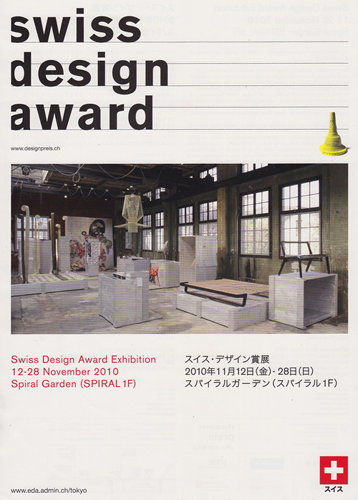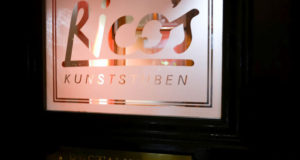The Swiss embassy has highlighted Swiss design as an important tool in promoting exports with an exhibition and a symposium in Tokyo. For the first time, nominations for the Swiss Design Award are being shown in Japan. Also, a symposium of highly renowned Swiss designers explored the origins of Swiss design and its relationship to design in Japan.
Exhibition in Aoyama
The exhibition in Aoyama Spiral Garden (until November 28) presents Swiss design in the broadest sense. Among the exhibited nominations for the Swiss Design Award 2009 is a sequin embroidery from fashion producer Jakob Schlaepfer, which changes color from black to white with a single brush of the hand. Also exhibited are stackable plastic chairs from Vitra, which resemble natural branches in form and color.
“Design is part of the creative industry and brings together art, culture, business and technology,” explained Swiss ambassador Urs Bucher at the opening of the exhibition. Design has the potential to create export revenue, jobs and profits, he said, adding that it would promote cultural diversity and human development. Promoting design, therefore, would be an important pillar both of Swiss export promotion and cultural diplomacy.
Swiss Design Award since 1989
The Swiss Design Award was founded 21 years ago to highlight the importance of Swiss design. Every two years, the prize is awarded by an international panel of judges. The competition is open to Swiss designers and products that are produced in Switzerland.
Prominent companies such as Vitra, Lantal Textiles, Nestlé Switzerland and Jakob Schlaepfer are represented in these awards. The competition also features the work of many renowned Swiss designers and labels, including Atelier Oï, Freitag, Jörg Boner, Fries & Zumbühl, Oskar Zieta and Holzer Kobler Architekturen.
“Ingenious Switzerland”
In late spring, a new export platform called “ingenious Switzerland” began its work. It promotes Swiss projects and products in the fields of architecture, engineering and design. Created at the initiative of the Swiss government with the support of the State Secretariat for Economic Affairs and Osec Business Network Switzerland, its main purpose is to provide international clients with a network of Swiss services and products of high added value.
According to Osec, numerous Swiss architects, engineers and designers have long benefited from international recognition. The particular fields they represent, however, have not yet succeeded in establishing themselves as a real economic force at international level. Reasons for this include the fragmentation of these fields, obstacles to export, foreign competitors being assisted by their governments, as well as the complex services and long cycles in these fields.
What is Swiss design?
At the Swiss Design Symposium, three designers from Switzerland discussed Swiss design with renowned Japanese designer Kenya Hara and Tokyo Wonder Site Director Yusaku Imamura. The symposium was organized by the Swiss embassy and the School of Cultural and Creative Studies of Aoyama University. Among the sponsors were Akris Japan, JykK Japan and USM U. Schaerer Sons.
Heidi Wegener, curator of the Swiss Design Award, described Swiss design as quality-conscious, minimalist, and durable, which contributes to ecological behavior. Even the Swiss flag indicates the Swiss peoples’ preference for simplicity, as well their stubbornness, as it is the only square flag in the world (with the exception of the Vatican flag). But Swiss design, she says, is also rather serious (“form follows function”) and lacking in “joie de vivre” and spectacular brilliance.
In the discussion, designer Frédéric Dedelley from Zurich saw Swiss design as being rooted in its topographic position: as a country in the middle of Europe, it is also in between rational Nordic design and playful Italian design, a typical example being Swatch clocks. His colleague Claudio Colluci, who is based in Japan, pointed to the necessity of mystery in good design, which he found in Japanese design. Daniel Freitag, inventor of the heavy duty bags made from truck tarpaulin, emphasized that Swiss design in the future needed sustainability as a new dimension.







